 Soila Sayialel asks... Care to Donate now? |
|
Volunteers Wanted
| |
Our Executive Director in Orlando is looking for volunteers with time to table, distribute literature, and help with fundraising events. If you live in or near the Orlando area, let us know. We would appreciate your help. Contact Betsy Swart at info@elephanttrust.org.
|
|
Amboseli Book Summary: Ecosystem Context
| |
In this Newsletter, we continue serialization of summaries of the chapters of our recent major scientific contribution, The Amboseli Elephants: A Long-Term Perspective on a Long-Lived Mammal.
Chapter 2 explores the Amboseli elephants' ecosystem home: challenging, variable, unpredictable and rich in biodiversity.
| 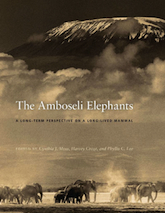
|
|
Names Needed
|
 | | TC calves playing |
| |
The baby boom continues in Amboseli with 148 new calves born since October 2011. We're daunted by the task of naming all the new calves, so we've decided to shorten the usual 4-year wait to assign names and ask you for ideas and help.
In ATE's long-standing naming program (click here for info), we ask for a donation of $2,500 to uniquely name and follow the life of an elephant. But given the number of names we need, we shall extend the special offer of $2,000 until the end of June.
Your donation will last a lifetime with a one-off payment. You'll receive photos of your elephant and its mother, a history and current structure of the family, and periodic updates. The calf with your chosen name will have just one sponsor -- you.
|
|
The Elephant's Sixth Toe
| | "Buried beneath the leathery skin of an elephant's foot lies one of anatomy's unappreciated mysteries. Three hundred years ago, a surgeon claimed elephants had six toes instead of the usual five, setting off a debate about whether an extra digit was really possible. Modern anatomists scoffed at the idea, insisting instead that the extra toe was really just a big lump of cartilage. Now a study of scores of elephant feet shows that the lump really does turn into bone. The digit is not a true toe-it's more like a panda's faux thumb. But it nonetheless helps support the pachyderm's mighty girth." Read the full Science Live report by Elizabeth Pennisi, with links to the original research by clicking here. |
|
|
KWS Elephant Strategy Launch
| | |
On February 22 the Kenya Wildlife Service (KWS) launched a national elephant conservation and management strategy. Several of us at ATE worked on the design and preparation of the strategy: Keith Lindsay and Winnie Kiiru were involved in the research and design, and Cynthia Moss attended the final workshop and was present at the launch.
The document provides a clear roadmap for conservation and management of elephants in Kenya for the next 10 years.
Speaking at the launch, the Minister for Forestry and Wildlife Hon Dr Noah Wekesa noted that the world was witnessing increased illegal killing of elephants and that the sophistication and the level of organization of illegal traders in ivory were also worrying. He announced that Kenya will be calling for a total ban on ivory trade at the next CITES meeting.
KWS Director Julius Kipng'etich said the strategy "has re-energized our efforts at research, protection, devolution of management, winning more wildlife space, human wildlife mitigation, capacity building of staff and other stakeholders, collaboration with partners as well as provided for benefit sharing with communities."
The elephant strategy seeks to maintain and expand elephant distribution and numbers, enhance security to elephants, reduce cases of human-elephant conflict and increase the value of elephants to people and habitats.
|
|
BBC Filming for "Survival"
|  | The BBC Natural History Unit has started filming for a new series called "Survival" which will be broadcast in 2014. One of the first shoots was in Amboseli. Producer Emma Napper and cameraman Martyn Colbeck were tasked to film the behavior between elephant mothers and new calves.
On this day they were thwarted by a huge male in musth who was not keen to let them go by. This is an ex-EB family male known as Little Male. Way back in history when he was first recorded he was a typical 5-6 year old male youngster with no distinguishing characteristics. In other words he was the quintessential "little male".
Of course, he grew up, left his family, kept growing as males do and today is a magnificent bull of 44 years old.
Being an Amboseli bull he didn't attack and eventually let them go on their way to find the mothers and babies. |
|
Update on the Albino Calves
| 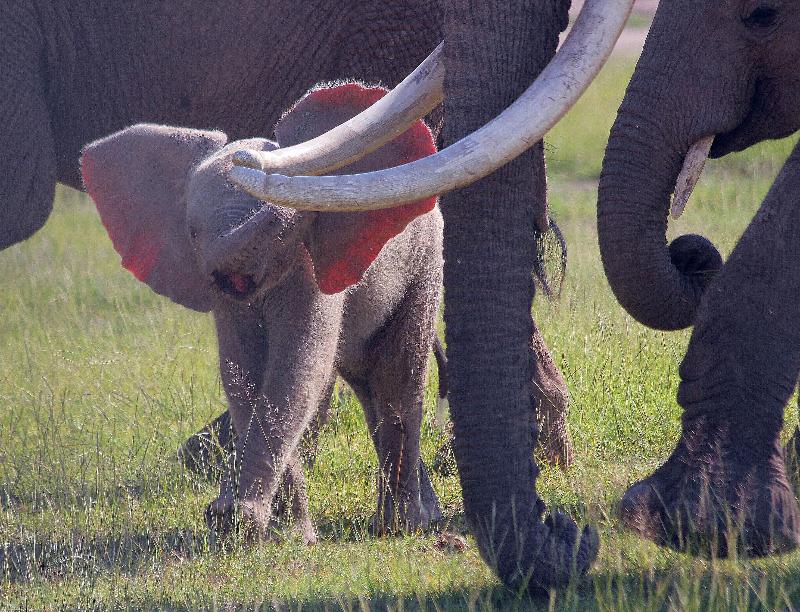 | |
We are happy to report that Jemima's albino calf is doing well. He's fat and happy and very active. Born in December he is now four months old and showing no ill effects from his condition. The skin on his ears is still very pink and the hair on his body and tail remain white. Otherwise he acts like any other bouncy, male calf of his age.
We have only seen the other albino calf twice and neither time could we get a photo, but he too seems to doing very well.
|
|
Celebrating Elephants at the Oakland Zoo
| |
Cynthia Moss will be the featured speaker on May 19 for the Oakland Zoo's 16th Annual Celebrating Elephants event this year. Last year one of ATE's Ph.D. student, Winnie Kiiru gave the lecture to a totally rapt audience.
Keith Lindsay (see the first of the main articles in this issue) gave two presentations at the Oakland Zoo in March.
We are pleased that the connection with the Oakland Zoo because ever stronger. Over the years the Zoo has raised over $200,000 for ATE and their support is greatly appreciated by all of us working to save elephants in the wild.
|
|
News from the Amboseli Trust for ElephantsMarch - April 2012
|
Greetings!
We at ATE have had a very busy few months, but they were busy in a good way. There were conferences, meetings and special ceremonies to attend. There were also media requests by TV and print journalists. Deputy Director Soila Sayialel was filmed and interviewed several times and I did an interview for BBC's Panorama, a current affairs program. This particular one was on poaching and the ivory trade. We have been saying yes to most journalists because we want people to be aware of the current situation for elephants in Africa.
We also worked with the media on a happier topic. A BBC film crew arrived on February 21 and filmed for nearly six weeks until March 29. We were all involved in helping the producer Emma Napper and cameraman Martyn Colbeck (see the photo and story in the sidebar) film the behavior of the elephant mothers and new calves.
We've also been very busy just trying to keep up with all the births. As I write this letter the number of calves born since the baby boom began on October 12 reached 148. There were 45 calves born in the last two and half months of 2011 and another 103 since the beginning of the year in a period of less than four months. That is definitely a record. And we're expecting more!
It is a total delight to be with the Amboseli families right now. After the horrible drought of 2009 they have been transformed from depressed, disrupted and fragmented groups to functioning families cooperating to raise their calves. Some families have as many as 10 calves and to sit with them and watch them learning, exploring and playing gives one a sense of renewal and hope.
We have our work cut out for us to make sure these calves are safe and can grow up in a world that allows people and elephants to coexist.
With continued thanks and appreciation for your support,
Cynthia Moss
DirectorAmboseli Trust for Elephants |
|
|
PAWS Elephant Summit -- Keith Lindsay
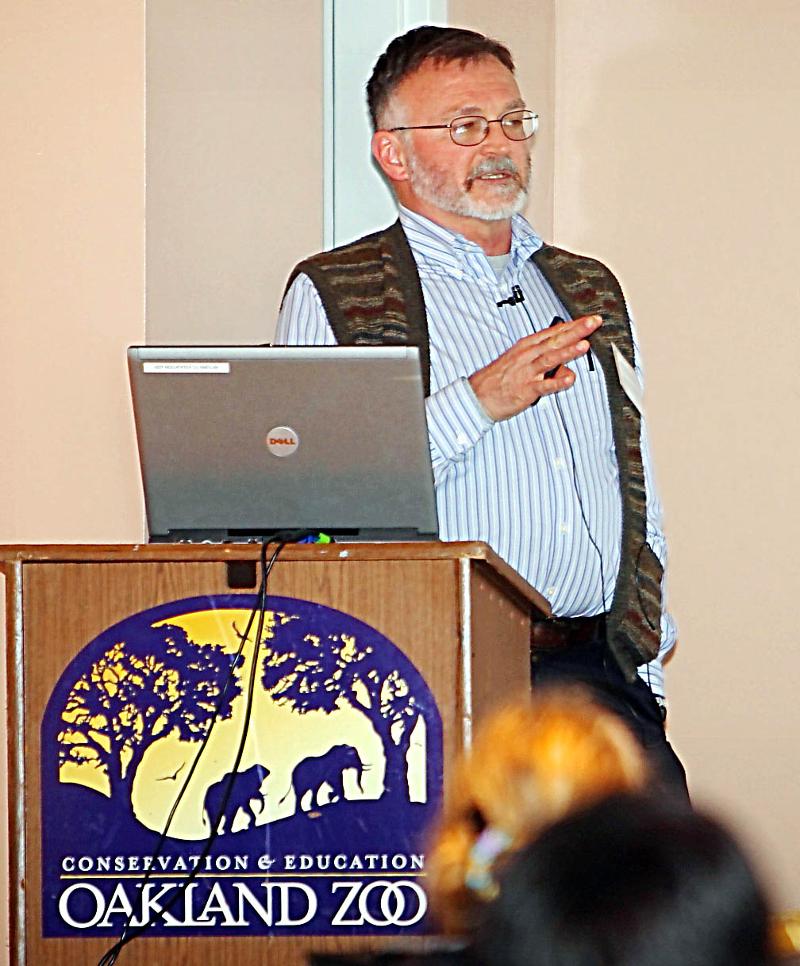 | |
Keith Lindsay speaking at the Elephant Summit
|
The Performing Animal Welfare Society (PAWS) held its fourth Summit for the Elephants March 28-30, 2012. I was fortunate enough to be invited to give a couple of talks, and to represent the Amboseli Trust for Elephants and its research wing the Amboseli Elephant Research Project (AERP) The meeting, held jointly with (and at) Oakland Zoo, attracted over 100 elephant advocates and experts from wide backgrounds: activists and campaigners, government agents, lawyers, veterinarians, trainers and welfare specialists, sanctuary founders and caregivers, zookeepers, writers, photographers, filmmakers and bloggers, and people who simply love elephants. Speakers and participants came from all over the world, including Kenya, India, Sri Lanka, The Netherlands, Belgium, Italy, UK, Norway, Brazil, Mexico, Canada and all parts of the USA. There were three full days of presentations and discussions, and opportunities for networking and lively conversation during breaks and evenings. Side events included a demonstration of protected contact training and husbandry techniques at the Zoo and a tour of PAWS' elephant sanctuary, ARK2000, on the weekend following the meeting. (See http://www.pawsweb.org/) Joel Parrott, DVM, Executive Director of Oakland Zoo, opened the meeting, along with and Pat Derby and Ed Stewart, Co-Founders of PAWS. They were ably supported by Colleen Kinzley (Director of Animal Care, Conservation and Research at the Zoo), and Margaret Whittaker, (PAWS consultant and animal training specialist with Active Environments), the excellent Zoo staff and many dedicated PAWS volunteers. The first day tackled advocacy campaigns and legal actions in the US and abroad; the second day focussed on captive elephant management in North America, Europe and India (with some input from our knowledge of wild elephants); and the third day covered captive and wild elephants in range countries. 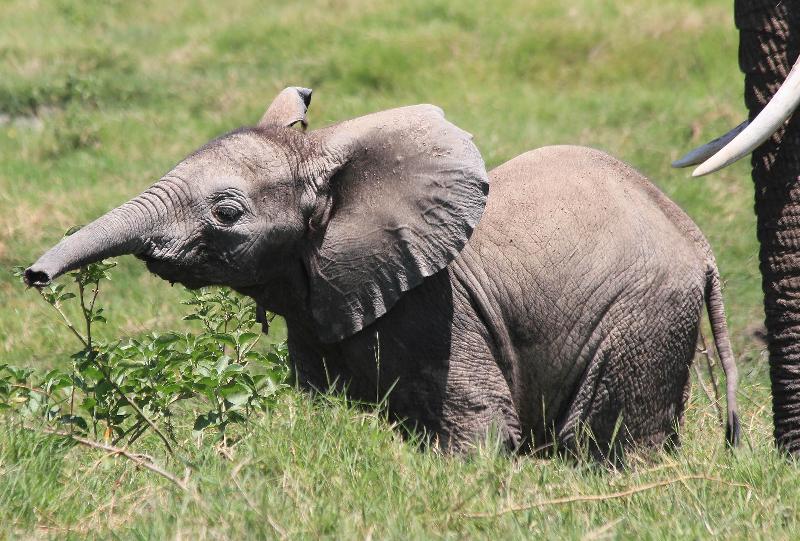 | | Seventy One |
I summarized AERP methods and results, as well as data from current tracking and demographic studies. In both talks on successive days, I stressed the crucial importance of research on the biology of wild elephants, in places like Amboseli, for the well being of elephants held in captivity. I announced to the meeting, and particularly to Pat and Ed, that two of the new calves in Amboseli have now been named "71" and Malugie: they have been named for rescued African elephants at PAWS. "71" was raised by Pat and Ed and, unfortunately, died recently and is sorely missed. The name Malugie represents Mara, Lulu and Maggie, the three African elephants currently at PAWS.  | |
Malugie
|
I had the chance to visit the Oakland Zoo, its elephants, and husbandry and research staff on the day before the meeting. I could see why this Zoo is considered among the most advanced in care of elephants. At the kind invitation of Pat and Ed, I also spent two days at the ARK2000 Sanctuary, getting to know the elephants and the systems in place for their care. PAWS justifiably represents the state of the art for captive elephants, and is a fine haven for former zoo and circus animals, where they can live reasonable lives for perhaps the first time. Everyone agreed that the 2012 Summit was the best so far, a valuable coming-together of expertise and energy for dialogue about the welfare of captive elephants. |
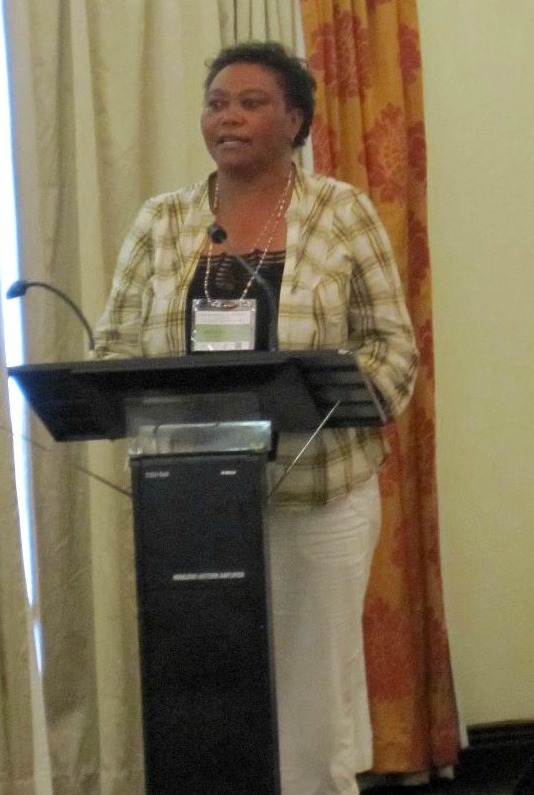 | |
In her role as Chairman of the Community Session,
Soila presents her group's conclusions
|
Cross-Border Elephant Meeting
In February Soila Sayialel and Cynthia Moss travelled to Arusha, Tanzania to attend a two-day meeting on cross-border collaboration for elephant conservation. The meeting was sponsored by the Liz Claiborne Art
Ortenberg Foundation (one of ATE's generous donors) and organized by the African Conservation Centre and the Wildlife Conservation Society. The overall goal was to bring together community representatives, conservation organizations and government agencies in the Kenya-Tanzania borderlands with the purpose of:
- assessing the status and movements of elephants
- identifying pathways needed to establish a viable interconnected elephant population
- strengthening community conservation capacity
- identifying how government agencies, conservation organizations and communities can work collaboratively
The meeting was very well attended by 65 participants with a very encouraging representation from local communities. After excellent introductory talks in the initial plenary session there were breakout sessions on community conservation, research and monitoring, and government oversight and coordination. Soila was made chairman of the community group. Cynthia joined the research group.
The Kenya-Tanzania borderlands are vital for the conservation of elephants in East Africa. They include the Maasai-Mara/Serengeti, Amboseli/Kilimanjaro/Longido and Tsavo/Mkomazi ecosystems and host large numbers of elephants residing inside and outside protected areas. Their future will be determined by cooperation between the two countries.
The meeting ended on a very positive note with everyone agreeing to more cross-border meetings and collaboration not just in community conservation and research but in anti-poaching as well.
| |
Elephant Babysitters -- Phyllis C. Lee
The current Amboseli "baby boom" provides a wonderful opportunity to explore how important families are in ensuring the survival and success of vulnerable calves. From our long-term observations, we have been able to show that the key helpers - which we call allomothers - of very young calves are juvenile and adolescent family females of about 4 to 12 years old. These young females work hard to help mothers and calves stay together when elephants are traveling and make sure that calves get moving again when the family starts to travel. Young calves have far less stamina then do the big females in their families; they lie down to rest whenever there is a moment's break. Calves will follow wherever their mothers go but in Amboseli that often involves going into cold, deep swamps. Their allomothers help them by sometimes staying on shore to keep them from getting cold and exhausted. It is often the allomother who runs to a distressed calf who is hurt or stuck in mud or holes. The mothers will always come if the job is too difficult for the young female. Allomothers also help calves get over logs, down and up riverbanks, and into and out of water.
Very young elephants sometimes seem not to be very sensible or aware of their surroundings, which makes their helpers, working along side mothers, vital to calf survival. We found that calf survival almost doubles when there are many allomothers, by comparison to when there are no helpers in a family.  | |
It takes a whole family: mothers and allomothers reassure a calf who cried out
|
Allomothers also touch, feel and smell calves, and the calves in turn use their trunks to explore their allomothers. We think that in this way calves are able to gain knowledge about the emotional states of others and the range of modalities of communication. So, as well as their role in caregiving, the allomothers provide opportunities for social learning in their young charges.
The younger allomothers, some of whom have only just been weaned themselves, also play with infants and this play is far more gentle and slower than the play with age-mates. Maybe this gentle contact play provides physical stimulation for calves; it also allows calves to test their strength and learn new "moves" in very safe and secure contexts during these games. Play also reveals the dynamics of social exchanges to these young animals; they experience how to take turns in play and when to push boundaries against older and wiser juveniles.
All of these interactions are vital for the physical, social and emotional development of young elephants, but allomothers have another role alongside the rest of the family. All members of a family will work together to protect calves from predators such as lions or hyenas. The whole family goes into defensive mode to chase away or evade predators, which are a real and ever present threat to calves (and even to juveniles and adolescents at times). This network of experiences within the family and even between families helps calves keep safe, provides vital social and environmental learning opportunities, and reinforces the lifetime bonds that exist between family members. |
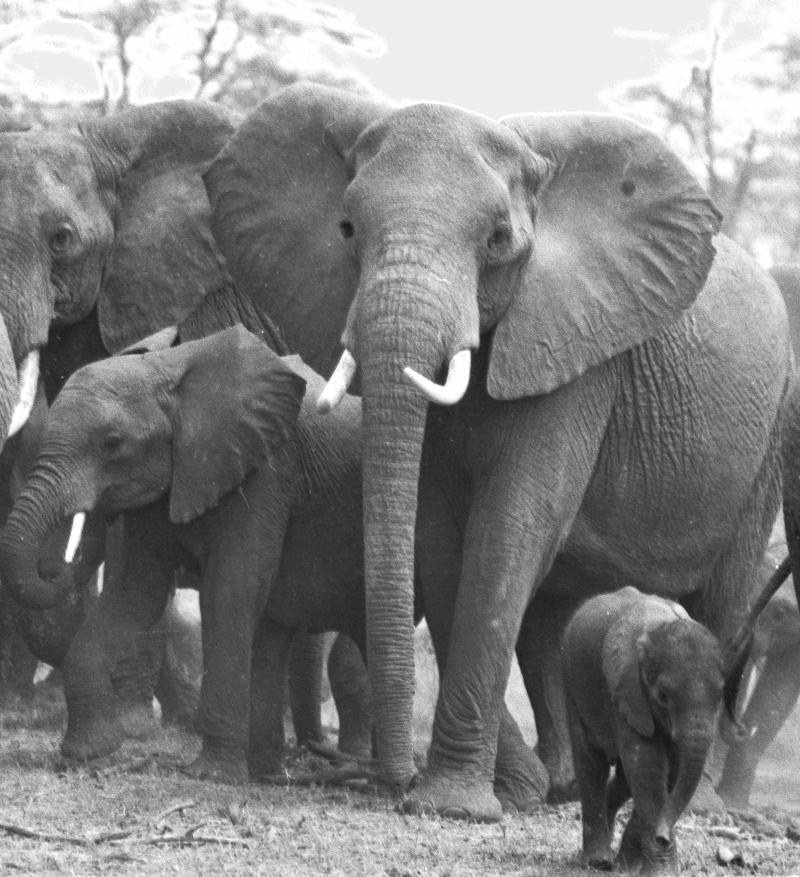 | |
Beautiful Olga on the day she was first recorded in October 1973
|
The History of the OA Family
I first met the OA family on October 20, 1973 early on in the study when I was working only part-time. They were in a large aggregation of about 100 elephants and about all I could do was photograph as many adult females as possible.
On April 10, 1974, I found a small family of seven females and calves plus one adult male. I recognized two of the females from the photographs I had taken the year before. This time I was able to get more photographs and begin to sort out who was in the family. There was an exceptionally beautiful matriarch and two younger females. The family appeared to consist of the following seven members:
Beautiful Matriarch adult female >35 years old
Calf about one year old
Younger adult female 18-20 years old
Tuskless female calf 3-4 years old
Young female with up-curved tusks 12-13 years old
Immature female 9-10 years old
Immature female 5-6 years old
I designated this family the OAs and named the matriarch Olga and the second adult female Orlanda. However, I did not see them again for over a year. I finally set up a camp and began working nearly full time in the Park in September 1975. One of the groups I found that first month was the OAs. I saw Orlanda in a big group of seventy elephants, but I did not see Olga or any of the others. With Orlanda was a tiny male calf about three months old.
On October 20, I found Orlanda with her new calf and her tuskless female calf, whom I decided to name Olive because without any tusks, she looked like the cartoon character Olive Oyl. The following month I found Orlanda with her two calves and the young female with the very up-curved tusks, whom I named Odette. By now I was wondering what had happened to Olga and the others. It seemed strange that they were not together because I was sure that they were the members of the same family.
I saw the family six times during 1976 but only Orlanda, her small calf, plus Olive and Odette were present. Sadly, I had to conclude that Olga and her young calf had died. There was considerable poaching around the Park in the first half of the '70s and many elephants were lost when they traveled out of the Park on wet season migrations. The poachers sought the bulls with their heavier tusks, but they would also take the bigger females.
To read the full history of the OA family Click Here.
|
 |
| Amboseli Book Chapter Summary: 2. Amboseli Ecosystem Context
Chapter 2, Amboseli Ecosystem Context: Past and Present, lays out the physical and ecological features of the Amboseli landscape. Variability and unpredictability are the hallmarks of semi-arid ecosystems that impose huge demands for resilience and adaptability on the resident plants and animals.
A vital feature of the Amboseli ecosystem is a series of five major swamps fed perennially from the sub-surface drainage of Kilimanjaro in Tanzania immediately to the south of Amboseli National Park. The swamps, and the grasslands and woodlands along their margins, support a remarkable array of large mammals (which the chapter catalogues briefly). Only two of the swamps are protected by the national park. The rest are under dire threat of permanent alienation from uncontrolled development.
Facts:
- Average Amboseli rainfall is only 340 mm (13 in) and highly variable from year to year. A Dry Season Intensity index shows there were 6 serious drought years and 11 relatively good years between 1972 and 2002.
- Amboseli National Park, the protected core of the elephants' range, at 390 km2 (150 mi2) is only 5% of the Amboseli ecosystem, as defined by the annual ranges of the large mammal community.
- The Amboseli basin, an ancient Pleistocene lake bed, is 1,100 m (3,600 ft) above sea level. The 5,892 m (19,330 ft) peak of Kilimanjaro, the tallest free-standing mountain in the world, is 40 km (25 mi) to the south.
- The elephants' total range (8,000 km2, 3,000 mi2) stretches more than 30 km (ca. 20 mi) across the international boundary into northern Tanzania.
- The elephant population has grown from 600-800 in 1972 to over 1,500 in 2010, ca. 3% annual increase. (It is now ca. 1,350 due to recent drought and poaching mortality.)
Amboseli is a 'non-equilibrium' ecosystem, in which there is no steady state and no prescribed target numbers corresponding to classical temperate zone 'carrying capacity'. Ecologists now know that the numbers, proportions and distribution of the plant and animal components of most ecosystems are in constant change, morphing over time and space from one state to another. The chapter concludes with an example of such a shift in Amboseli. Over the years the face of Amboseli shifts aperiodically from more-woodland-less-swamp to more-swamp-less-woodland. Change is the name of the game, and that is what the elephants and other wildlife (and wildlife managers!) have to cope with.
|
|
|
As I write this concluding message, I just got word that we had another 16mm of rain in Amboseli. This kind of news always makes us happy. Amboseli is a semi-arid savannah with very unpredictable rainfall, as you will have read in the above summary of Chapter 2 from The Amboseli Elephants.
Rain is life. All the new calves in Amboseli have no idea how lucky they are to be born in such a good year. Their mothers have plenty to eat and drink and are thus able to produce the milk necessary to sustain them. Of the 148 calves born only two have died. That's a record as well as the number of births.
Now if we can just assure their safety from poachers and human-wildlife conflict. We continue to work hard on both fronts. The calves spur us on.
Cynthia Moss
Amboseli Trust for Elephants |
|
|